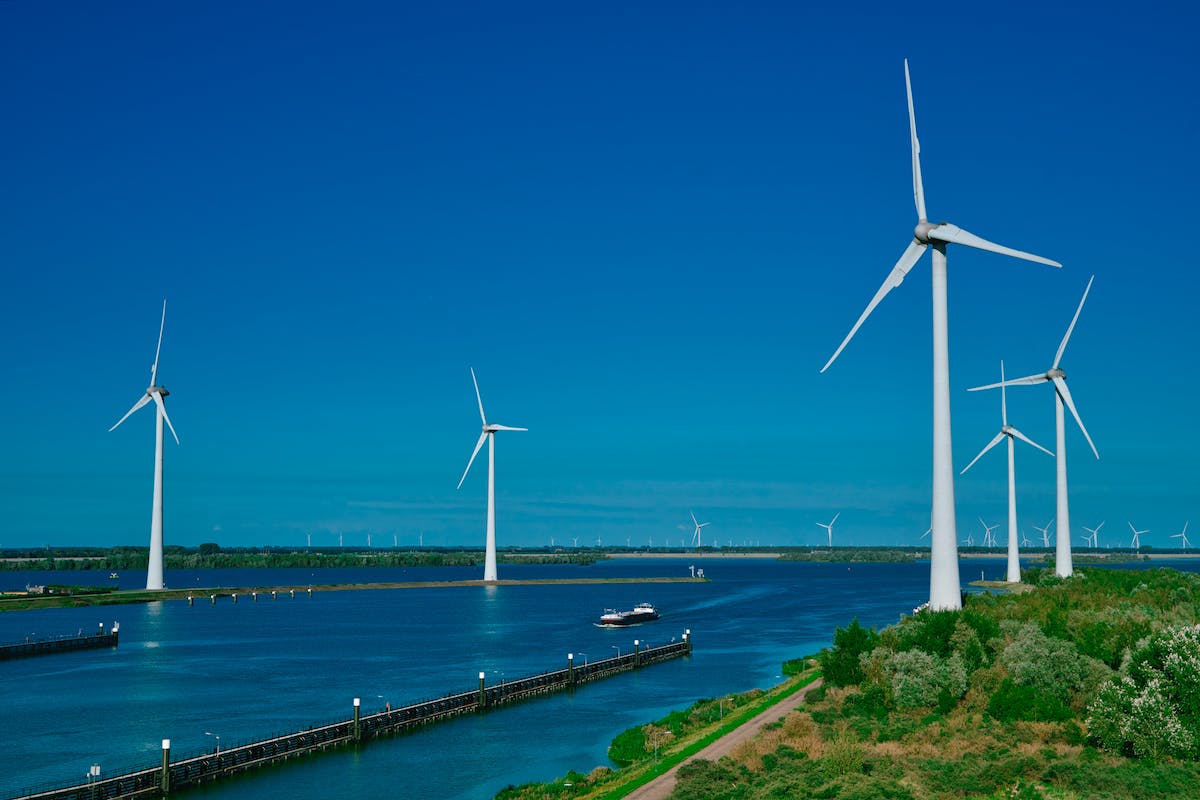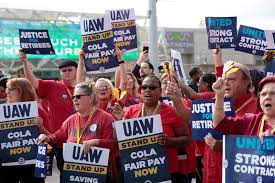Menu
Just Transition Insights, Issue #21, 09/18/2023
By Jonathan Tasini
|

Leading Off: The Sketchy “Every Reasonable Effort” Standard
We have an iron-clad guideline for parsing Just Transition plans, not to mention life in general: read the damn details.
The fancy slogans or promises for a Just Transition are alluring. But, what will matter to workers’ futures are the boring specifics, buried in often mind-numbingly boring agreements.
We’ve got an example that illustrates the “read the damn details” principle. And we will make that principle a regular feature here.
Today, let’s look at the ever-growing offshore wind sector, an industry that is touted throughout the world as both a replacement for fossil fuel-generated energy and a source for future jobs for workers who will lose employment in fossil fuel industries.
The U.S. government has been auctioning leases for such projects. Here, for example, is the May 2022 announcement by the Department of the Interior of an auction [we have added the bold portion]:
The Department of the Interior today announced results from its wind energy auction in the Carolina Long Bay area, the second major offshore wind lease sale this year and a significant milestone towards achieving the Biden-Harris administration’s goal of deploying 30 gigawatts of offshore wind energy capacity by 2030.
“The Biden-Harris administration is moving forward at the pace and scale required to help achieve the President’s goals to make offshore wind energy a reality for the United States,” said Secretary Deb Haaland. “Together with an all-of-government approach, we can combat the effects of climate change while creating good-paying union jobs that can benefit underserved communities. Today’s lease sale is further proof that there is strong industry interest and that America’s clean energy transition is here.”
This particular auction had two winners: TotalEnergies Renewables USA, LLC and Cinergy Corp. (formerly Duke Energy Renewables Wind, LLC).
We were curious what the executed leases required of the winners in the standards for workers to create “good paying jobs”.
If you scroll all the way down to page 32 of the agreement with TotalEnergies Renewables USA, you will find a heading, Clause 6, entitled “PROJECT LABOR AGREEMENTS” (yes, it’s in all CAPS). There’s only one point to the clause, 6.1:
The Lessee shall make every reasonable effort to enter a Project Labor Agreement(s) (PLA) that covers the construction stage of any project proposed for the leased area, and that applies to all contractors.
That is the boilerplate language, word-for-word, that you can find in any of the executed leases for similar projects.
So, first, as background, for readers outside the U.S., here’s a compact explanation of project labor agreements:
Project labor agreements (PLAs) are used primarily in the construction industry to establish the terms of employment for all workers on a project. Generally, PLAs specify workers’ wages and fringe benefits and may include provisions requiring contractors to hire workers through union hiring halls, otherwise establish a unionized workforce, or develop procedures for resolving employment disputes. PLAs often include language that prevents workers from striking during the project while also preventing employers from locking workers out.
In other words, PLAs unionize the project, but not, long term, a company. That’s a very common reality within the construction industry, for a whole set of historical reasons that, for brevity sake, we leave aside. We also put aside, for the moment, the question of how many actual jobs are to be found in such projects, and what permanent jobs will a project offer once the initial construction phase is finished—all important issues for assessing whether a “high bar” Just Transition is underway.
The simple question today is: what is the definition of “every reasonable effort“?
No one knows.
It’s not spelled out in the agreement. The agreement does not list standards that would tell anyone whether an employer engaged in “every reasonable effort” to reach a PLA. Nor, as far as we have found, is there another public source that delineates what “every reasonable effort” means. Is a phone call to the CEO’s mama asking whether she knows of a union to bargain a PLA enough to fulfill “every reasonable effort“?
We want to be smarter. So, we’ve asked a set of questions to the people in charge at the Bureau of Ocean Energy Management (BOEM), a department within the U.S. Department of the Interior that is the front-line agency responsible for these leases: is there a department/other description that further describes/defines what “every reasonable effort” means/requires? Is it postings for jobs? Negotiation with a relevant union? In other words, how does one adhere to that standard, and how does the BOEM /or other agency evaluate compliance?
So far, to our questions, crickets. We will bring to our readers any response, should it be offered.
But, you can see the problem: there is no clear standard.
And this is precisely, to date, the problem across the globe with the entire concept of “Just Transition”: it’s too often an empty slogan. A phrase that can be embraced by a broad swath of players without any clear idea of what the details are.
Which is not a path to a secure future for workers.
SPONSOR MESSAGE
A message from the Maritime Union of Australia
The MUA is proud of the high union density in the maritime industries, and encourages all maritime workers to join the union to benefit from the solidarity and collectivism that unionism brings. Learn more about our campaigns on behalf of maritime workers here.

Spotlight: The UAW Strike & Just Transition
As we are poised to send this issue to our readers, the targeted strike by the U.S. United Auto Workers is entering its fourth day. It is a fundamental marker for the efforts to ensure a “high bar” Just Transition.
Auto workers are facing a five-alarm urgency. They face near-term negative consequences from the climate change-sparked industrial shifts, unlike other workers in other industries who are likely to face disruption that unfolds over a longer time frame due to the de-carbonization movement afoot: the shift to electric vehicles is happening right now.
The landscape is grim: there is no concrete plan for a “high bar” Just Transition for auto workers, which would require a mix of employer-union negotiated agreements and, most likely, support from national governments, either via expanded benefits and/or direct cash support. As we often point out a “high bar” Just Transition will prevent the creation of thousands of economic wastelands, which will be the inevitable outcome when communities do not have the wherewithal to respond when whole swaths of jobs disappear and tax bases are eroded.
Auto companies simply say: we will have fewer workers. Full stop. Ford predicts it will employ 40 percent fewer workers on its assembly lines once it has fully moved to electric vehicle production. Stellantis goes even further, pegging a 60 percent cut in its assembly line workforce within a decade.
Tesla is boldly anti-union. This year, it fired a group of workers 24 hours after the workers went public with a unionization campaign. And is now embarking on negotiations to set up a manufacturing facility in Saudi Arabia where independent unions are virtually non-existent.
In fact, the UAW published a “white paper” recently, using a vote at the battery plant owned by Ultium (a joint venture between General Motors and LG Energy Solutions) as the backdrop for sketching out a future for workers in new industries arising from climate change transition. The conclusions of the paper mirror quite closely the “high bar” Just Transition advocated by our efforts:
In a just transition to EVs, jobs in the battery plants that will power this transition must be as good or better than current jobs building ICE vehicles and components. Unfortunately, there are troubling signs regarding the transition’s impact on workers. Not only are hourly wages in EV battery plants much less than in existing powertrain facilities, there are significant concerns that their health and safety practices fall far short of the unionized auto industry’s standards.
Fortunately, addressing job quality and health & safety concerns in the emerging EV industry does not require reinventing the wheel. Through decades of collective bargaining, the unionized auto industry has a well-established set of robust health and safety programs that protect workers from hazards and provide for worker participation. These programs have been enshrined in collective bargaining agreements.
Automakers and their battery partners have a responsibility to apply the same industry-leading health and safety programs to their battery operations that they use in unionized automotive plants. By adopting the standards in line with those in the UAW’s Big Three Master Agreements throughout the electric vehicle supply chain, we have the opportunity to set a high bar for this new auto powertrain. Most, if not all, of the health and safety concerns found at Ultium’s Lordstown plant could be avoided by applying UAW-negotiated Big Three industry standards.
There will be tens of thousands of workers in battery plants in the near future. Establishing best practices at these plants now will set a high bar throughout the industry. Workers across the supply chain, from mining and mineral processing through final assembly of EVs, will be dealing with many hazards similar to those faced by workers at Ultium in Lordstown. Ramping up EV production to reduce climate impacts must not result in spreading dangerous manufacturing practices to communities across the country. All EV workers deserve robust protections and a voice in making their jobs safer.
Thus, the current strike, while fighting crucial issues such as increasing pay and getting rid of two-tiered wage scales, will fundamentally set a Just Transition standard that will likely be the basis for the future for auto workers for a generation or more.
Ideas: Home Loans & Just Transition Redux
The rise in interest rates globally is a financial burden on workers. A key aspect of the burden is the higher mortgage rates on homes—people now pay a lot more for a new home payment.
So, we thought it a good time to circle back to an idea we put forth in the past: making home loans a part of Just Transition.
One of the toughest parts of enduring a transition into a new job is being forced to uproot from a community a worker has lived in for a long time, sometimes a community that has been home to generations of one family (we are thinking of many coal mining communities throughout the planet). There is the emotional upheaval.
And, as important, there is a financial burden, especially when a worker is forced to sell a house s/he bought many years ago at an affordable price in order to move for a new job to another community where housing prices are stiffer and, certainly, higher than in the past. Now, with interest rates having risen rapidly in many parts of the globe, the financial stress has multiplied and made the idea of moving even more difficult—a sale of a current house will be slower and, possibly, return less, exacerbating the challenge of finding an affordable home in a new location.
So, why not work into every Just Transition proposal a financial support system for securing safe, affordable housing? We think such a proposal could, at the very least, offer close-to-zero interest rates and no down payments, terms that would be guaranteed and backstopped by governments.
Models exist already in the space of transitions—we are thinking particularly of transitions made by millions of U.S. military service personnel who end their time in uniform and, then, move back into civilian life. The U.S. government has a variety of programs, depending on service, administered thorough its Department of Veterans Affairs. For example:
If you’ve served for at least 90 continuous days (all at once, without a break in service), you meet the minimum active-duty service requirement.
The process is not that mysterious:
You’ll go through a private lender, like a bank or mortgage company, to get this loan. We’ll guarantee part of the loan against loss, which will allow your lender to give you better loan terms, like the option to pay no down payment.
Right now, no financial Just Transition package—or even simply a framework discussion—includes housing. The handful of transition packages we have studied globally have only a bare-bones, non-salary element—a small amount for retraining and, perhaps, a very small “transition” lump sum, none of which comes close to factoring in housing costs.
It would be simple to add housing costs to a transition package—and make real sense looking at the challenges many workers face taking on a new job. Affordable for the individual and the state. We could even envision a multi-year, government-backed housing projects initiative in which homes are built for workers transitioning from a fossil-fuel job.

Opinion: A Just or Unjust Transition: the Trinidad and Tobago Experience
By Ozzi Warwick
It is understood in Trinidad and Tobago, that our islands and islands in the Caribbean are facing the existential threat of the effects of climate change. The fact is, that the Oilfields Workers’ Trade Union (OWTU) does recognise that climate change is real and currently happening around the world and particularly impacting smaller island states. Therefore, we understand that in Trinidad and Tobago, a carbon reduction strategy is needed to be developed to deal with the high emission from the power generation, transportation and industrial sector.
The OWTU is very clear that every decision our generation makes directly affects the generation to come. The OWTU also understands that we all need to play our role in protecting the environment and creating a sustainable economy while attaining this. Therefore, the “Just Transition” framework was created to ensure a shift from an extractive economy to a regenerative economy. Although the Just Transition appears to be a positive outlook at protecting both the environment and the people who are directly affected, with poor leadership skills from governments and poor planning this can take a negative turn and harmful impact on the future generation
The concept of a Just Transition which emerged from the trade union movement as a means to address the climate crisis in a more just, equitable and fair manner, is being coopted to advance another agenda amidst the crisis of capitalism. It must always be made clear that the contradictions of capitalism have caused the crisis of climate change that we see today. The solutions to the crisis of capitalism do not lie in finding the appropriate regulation, but in the extent to which social movements are able to wage a worldwide process of class struggle from below, that seeks profound changes in the relations of production in energy and the reproduction of human life.
We should start with a fundamental proposition: Energy is a human right and therefore we believe in public ownership of energy. This really should be at the heart of any discussion around a just transition. Also at the heart of a just transition is job security for the working class. According to IndustriALL Global Union, a Just Transition’s objective is to provide an optimistic future for all workers. They also stated that at all times, any public policy support must guarantee the Fundamental Principles and Rights at Work as defined by the 1998 ILO declaration. Union members’ rights must be protected during any transition.
For the transition to be “just” there will be the need for more than political will and rhetorical statements about ending the fossil fuel industry. What will be required is the genuine and active participation of stakeholders based on human rights or else it will be considered simply a “transition” into a green economy. Trade Unions have shown that the transition can only be “just” when all stakeholders are seated at the table, building and creating the plans for a Just Transition.
This means that there has to be a win/win outcome, but that outcome would have to play itself out in class struggle. Any ‘just transition’ if driven by the government without sufficient participation and involvement of trade unions can become a weapon against the working class. In Trinidad and Tobago whilst the government presents a “draft just transition policy” they have in fact embarked on a transition of sorts and it is certainly anything but just. The government allowed the closure of the country’s only steel plant, several petrochemical and manufacturing plants. The government also sent home all the workers from the integrated state own oil company and closed the refinery. They have reduced subsidies aimed to benefit the poor five times; engaged in privatization under the guise of restructuring and have been attempting to eliminate collective agreements and collective bargaining by the state. Talks by government officials about “reskilling”, “retooling” and “capacity development” are fictional. In the past six years and for the 20,000 people who lost their jobs, where was the “reskilling and retooling”? where was the “capacity development.”? These promises never materialized.
What has materialized is a transition that left tens of thousands of citizens and their families displaced and dispossessed. The Trinidad and Tobago transition is in fact a process of neo-liberalizing the state where profit is placed at the centre before people. There are really three main messages coming out of our experience. One, is that the neoliberal approach to climate protection and energy transition is failing. Two, hiding behind climate concerns, the G7, the IMF, the World Bank, etc., are pushing a “green structural adjustment” agenda. Three, the need for a public pathway approach to climate protection, energy transition, and the need to address energy poverty.
Neo-liberalism created a reordering and rethinking of our status as individuals. For instance, think of the free market which has integrated into all of society until it has invaded its way into our personal lives. Individuals who are well-educated, skilled workers and healthy stand a better chance of getting jobs in today’s society. Therefore, the combination of a continuing emphasis on reducing benefits and the existence of a high unemployment rate has led many people to poverty. It must never be forgotten that neo-liberalism aims to lower wages, reduce benefits, destroy the health and education system, and create funding from national and international welfare.
In Trinidad and Tobago, the neoliberal market restructuring began in the 1980s, when the country accepted structural adjustment loans from the International Monetary Fund (IMF) in the wake of declining oil prices. Trinidad and Tobago’s neo-liberal policies then began extracting the wealth of its citizens and transferring it to the upper class of society. Therefore, it would be important to identify whether the government’s current Draft Just Transition Policy document is really a continuation of this process.
The Draft Policy being pursued amounts to a “structural adjustment program,” packaged in such a way that it appears to be motivated by ecological concerns, particularly the need to address climate change, when in fact it aims to advance further privatization, commodification and liberalization of the country. The marketisation and privatization of public energy systems are central to the Draft Policy strategy in order to create an “enabling environment” for more private sector participation.
However, this strategy will not work because private capital will demand terms that are heavily skewed towards securing revenue streams and high levels of profit. The Draft Policy also introduced de-risking as a strategy but all the evidence has shown that de-risking simply shifts the risks from private to public.
It is based on a number of wrong assumptions. The Draft Policy claims that there is “a global trend towards decarbonization.” This is a wrong assumption statement as some developed economies are decarbonizing their power sectors, but this is not a “global trend.” In fact, gas and oil consumption has been on an upward trajectory for many years. The Draft Policy also claims that the decarbonization process will automatically lead to lower demand for oil and gas and therefore lower prices. However, what evidence suggests is really energy expansion with growing demands with not only a return to the pre-pandemic prices but we have seen it soaring in actuality.
Another wrong assumption being made by the Draft Policy is that “The trend of global investment in renewable energy is increasing.” But this is misleading. Bloomberg New Energy Finance recently reported that $303.5 billion was invested in new projects and small-scale systems in 2020, a 2% increase over 2019. But in real dollars, investment in renewable energy has flatlined since 2012. Furthermore, the $303.5 billion total includes biofuels and biomass.
It can be noted that Trinidad and Tobago have seen a reduction from 2017 global emission of 0.11% to 2019 0.10%. The government aims to achieve a reduction in the overall emissions from the three sectors by 15% in their 2030 vision. In order to reduce our emissions, the government has estimated a cost of USD 2 billion, which will be generated through domestic funding (taxes) and from the Green Climate Fund. According to the Green Climate Fund, currently, Trinidad and Tobago readiness support is approved for USD 1.7 Million of which USD 606.8 thousand readiness supports have already been disbursed. We as stakeholders, are yet to see how the money has been disbursed. On the other hand, in Trinidad and Tobago, there is a lack of data and information found on recent trends in the climate change of our country.
The Multilateral Environmental Agreements Unit, in the Ministry of Planning and Development, admitted that there is a gap in data in the public domain, especially verifiable data about the statistics available. Instead of attempting to push through a neo-liberal agenda under the guise of a just transition, the government’s first priority should be gathering more updated statistics on GHG emissions. Precise and accurate research should be taken, to gather the right amount of data needed before imposing a destructive neo-liberal agenda under the guise of reducing our CO2 emissions. Seeing that Trinidad and Tobago is only emitting 0.10% as per the latest data, our government should take an approach that takes into consideration how the neo-liberal measures contained in the Draft Policy do not only affect the environment but also the community as a whole.
In our aim to reduce our country’s carbon footprint, one may consider the many types of renewable energy to power Trinidad and Tobago. A question that arises is whether we can transition to another option, where we rely solely on renewable energy. Government should then consider the effects it may have on our country and whether these renewable energies can sustain our energy sector. We can already assume that renewable energy may not be solely sustainable in Trinidad and Tobago. Wind energy requires a large landscape to build on, which Trinidad and Tobago will find difficult to source, while solar energy is very costly to power entire households, hydroelectric energy is challenging to maintain and Trinidad and Tobago is not suitable for geothermal energy.
There is no doubt that we in the trade union movement acknowledge the climate crisis but we also note the failure of the “liberalize and privatize to decarbonize”. We Reject privatization and liberalization as this is not a viable path to decarbonization. We are convinced that the proposed Just Transition Policy if implemented, will produce negative and regressive social outcomes. We support defending and reclaiming energy systems to full public ownership as a means of ensuring a planned and equitable transition.
As it stands today, with support from Trade Unions for Energy Democracy (TUED) the Union has been able to stall the government’s decision to implement the policy and is prepared to engage in public education and mobilization to rally workers and communities around an alternative approach to the neoliberal approach being advanced by the government.
Leading up to COP 27 the government hosted a consultation where they presented the Draft Policy which was more public relations than substance. The Union had to intervene to highlight the implications of the policy and to raise awareness of the hidden neoliberal agenda contained in the Draft Policy. The trade union movement will be embarking on a series of public events to rally national support to force the government to engage in a proper and genuine process of just transition.
The policy is still before the Cabinet so we still have an opportunity to ensure that any transition will not be like the previous transition the country experienced which leaves greater power in the hands of capital at the expense of labour. We, therefore, are mobilizing for a major policy shift that can establish a “public goods” framework for a progressive just transition. In the coming weeks, early in the new year, the trade union movement will engage in more intense education, awareness raising and mass action for a Progressive Just Transition.
Warwick is the Chief Education and Research Officer for the Oilfields Workers’ Trade Union of Trinidad and Tobago
Links
UAW: The United Auto Workers website for up-to-date information on the current strike.
Table of Contents
Leading Off
The Sketchy "Every Reasonable Effort" Standard
Spotlight
The UAW Strike & Just Transition
Ideas
Home Loans & Just Transition Redux
Opinion
A Just or Unjust Transition: the Trinidad and Tobago Experience
Links
This Week's Links
Can’t wait to subscribe to the newsletter?
*We post information pursuant to the U.S. Fair Use Doctrine, and applicable international standards, in order to advance the knowledge base and education of our global audience. We endeavor to include the original link to documents. However, upon requests of original authors of posted documents, where explicit use permission is not granted, we will remove documents if it is determined continued use is not appropriate. We also reserve the full right to not include, or remove, any data inconsistent with our mission.















